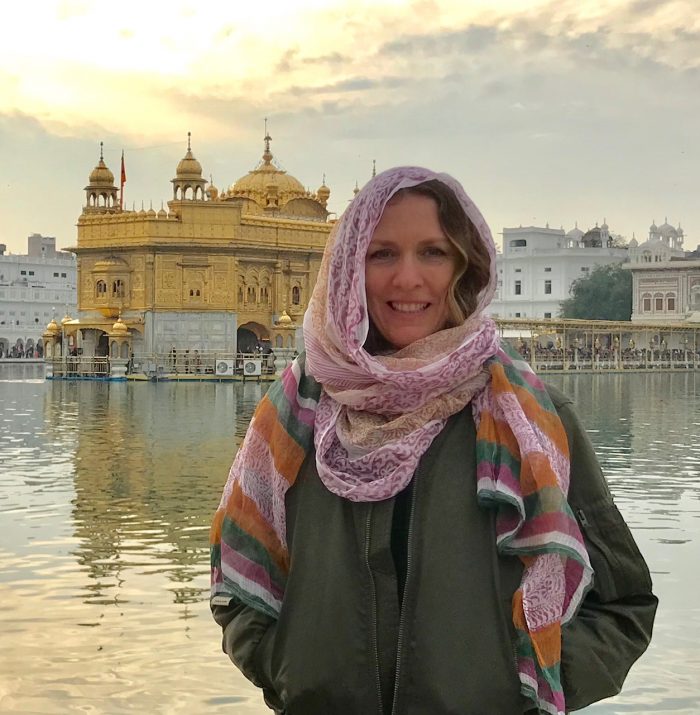From my early teenage years, I was obsessed with all things “foreign.” I grew up in the rural Midwest and to me, anything from another part of the world seemed exotic and somehow better. As a fashion student in college, I developed a keen interest in India through my study of textiles. India has been exporting textiles since at least 4000 BC. In my twenties, I discovered Indian cuisine. I would drive an hour one way just to eat at my favorite Indian restaurant. To this day, I eat more Indian food than “American.”
At the age of 29, I discovered yoga. My practice quickly grew from an exercise routine into a full-blown obsession with the history and philosophy of yoga. I read yoga books and practiced daily. I became certified as a teacher after realizing through my own experience the life-changing possibilities yoga offers.
For years I wondered why anyone would go all the way to India to study yoga. Don’t we have enough experienced yoga teachers to learn from here in the US? As my practice evolved, my ideas about traveling to India changed. I wanted to go there to gain a better understanding of yoga’s roots. I wanted a direct experience of the culture that spawned the blueprint from which I had chosen to construct my life. So, last year I decided that it was time to make the trek—time to meet my “Mother.”
My flight left our little town of Asheville, NC on a cold February morning. As I looked down from whence I came, I felt twinges of excitement and guilt about leaving behind my life (dog, boyfriend, work.) I felt myself leaving one reality of space and time and entering a sky realm of in-between. I sensed that my perception of the world was about to broaden.
When I emerged from the plane 15 hours later, I recognized immediately that something was different. Delhi, India holds both an innocence and an astute nature that I had not previously felt nor seen. I couldn’t stop looking at everything. I knew I was in a different world and I couldn’t wait to see more. I barely slept that first night. My heart swelled with both contentment and excitement.
India is a developing country in a state of transition, fueled by the growing middle class. It seeks to emerge as a progressive, and forward-thinking society away from its traditional past. Textiles, tourism and the IT industry offer a bright and hopeful future for young Indians. Modern Delhi is very different from the fantastical land of magic carpets and turbans I had imagined in my youth. With roughly 25 million people, (imagine that — NYC has only 8.6 million) Delhi is a hub of education, industry and international commerce.
In the following two weeks, we visited temples, ashrams, villages, and markets. We traveled by car and by train in order to see the countryside up close and personal. We traveled through small villages where entire families live together in tiny one-room homes. I felt a strong sense of familial bonds and the powerful presence of cultural tradition in these villages. It felt as if we had traveled back in time. In the cities, we saw rickshaw drivers sleeping on their tricycles, business owners living in their shops, and many people sleeping wherever they could claim a space. As I had anticipated, there were children and adults begging for money and food. While some were more persistent than others, I never detected aggression or felt threatened.
It is estimated that there are 1.8 million homeless people in India. The Indian government defines “homeless” as people who do not live in houses counted in the national census, but rather stay on pavements, roadsides, railway platforms, staircases, in temples, streets, pipes, or other open spaces.
There is a sense of impermanence about everything in India. Something catches your eye and you turn your head to get a better look, but the fleeting moment has already passed. I was often left wondering if what I was seeing was real. Did that really just happen? Did I just see what I think I saw…or did I imagine it? Life in India is happening out loud, in technicolor right there in front of you. You can’t escape or ignore it even if you try.
Imagine India in its evolutionary past, many thousands of years older than the United States. Lore has it that the very first yogis were seeking solace from life’s suffering. They realized that everything is always changing and trying to hold onto anything inevitably leads to the pain of loss. Imagine living in a world with so much constant turmoil, activity, and change that the only place they had left to look for a sense of permanence and peace was inward. I could relate to this more clearly as I watched the activity all around me.
The people of ancient India saw value in the knowledge that the yogis obtained through their sadhanas (spiritual exercises.) The society held them in high esteem and supported their work. Through the experiences told by the yogis, people could get a glimpse, an earthly preview of Moksha. Moksha (also known as Mukti) is the concept of ultimate freedom and liberation in Indian philosophy and religion. It is a transcendental state in which there is absolute peace and oneness with the Divine. In the state of Moksha, the subject is released from the limitations of worldly existence.
I found in India a different level of comfort walking amongst others whose fundamental belief system regarding the nature of reality was the same as mine. There were themes from yoga philosophy that seemed embedded in Indian culture (e.g. non-violence, a balance of effort and ease, surrender, go with the flow.) I wanted to find out more about this culture that spawned a practice so powerful that it changes people’s lives profoundly and permanently.
From an outsider’s perspective, the caste system in India is a bit of a mystery. As Westerners, we can only imagine all the little nuances that go along with it. Discrimination based on caste is illegal in India but is still a social concern. Vedanta, Yoga, and Tantra developed outside of mainstream society in hidden forest retreats and caves. The seeker renounced community and caste and was free from all social obligations. The caste system was not only rejected by the Yogis, but also by the Buddhists, the Jains, and the Sikhs.
India is the world’s largest democracy with a mixed capitalist and socialist economic system. The more than 2,000-year-old caste system is perhaps the world’s longest surviving social hierarchy. A person is a member of the caste into which he or she is born and remains within that caste until death. Originally the castes were differentiated by the work performed in society but soon caste became hereditary. The four castes are the Brahmins (priests and teachers), the Kshatriyas (kings and warriors), the Vaisyas (merchants, traders, and skilled artisans), and the Shudras (laborers and servants). A fifth category falls outside the system and consists of those known as “untouchables” or Dalits; they are often assigned tasks considered too menial or degrading to be performed by caste members.
I couldn’t help but wonder about the reason for the popularity of yoga in America. Could material wealth and success have rendered yoga, a practice based on minimizing suffering, no longer necessary?
Unfortunate leadership and an uncertain future for our evolving capitalist democracy loom over the United States. With a declining job market and a dwindling middle class, there is an obsession in American culture with acquiring and maintaining material wealth. The quest to own more is perhaps stronger than ever. Not unlike the caste system, we are all born into a particular socio-economic bracket. In America, the hope of moving to a higher level, or the danger of falling to a lower level are often the motivators behind the way we spend our time. The family unit has lost its importance. Elders are often left alone or tucked away in facilities as we are too busy to care for them in our own homes. Our society is becoming more and more based on a virtual world where we project our avatars and interact with others in cyberspace. Life is a series of memes. Americans seek to project the illusion of perfection.
As a result, we are isolating the only part of yoga that fits neatly into our culture (postures for exercise) and capitalizing on it. In America, the practice of yoga for most practitioners begins as nothing more than a workout. Students become customers and teachers become workers in the new “service industry” of Yoga.
Suffering comes from our inner world, our inner experience. Perhaps more clearly stated, it comes from identifying falsely with our outer experience. It comes from mistaking the gross world as the only world. Indeed, the relentless quest for material success and physical perfection appears to be enough of a prison of its own to drive one inward for solace. As the modern guru, Shri K. Patthabi Jois said, “Do your practice and all is coming.” A growing percentage of those “physical fitness yogis” are practicing long enough to notice the profound effects that go far beyond the physical.
If the last of the master yogis are currently living out their lives, and there is no longer a culture or social structure to support the deeper study of yoga, who will teach these new seekers? It is my intention that the “Spiritual Tour of India” will become an educational tool to help keep the path of the original yoga alive.
At dusk on the rainy eve of my departure, during my final tuk-tuk ride through the streets of Delhi, I sat wrapped in my shawl. The driver was going a little too fast and I held tightly to my seat, tense from the chill in the damp air. With the wind and a light drizzle on my face, I had not a care in the world. My entire being was filled with newly acquired information. We know what we know only from experience. There was no need to try to sort it out or find meaning in it now. I would allow the experience to exist without making it smaller by confining it to words. India is at once romantic, impressionist and surreal. Om Namah Shivaya.







Read 0 comments and reply